Analyzing Cross-Cultural Management Challenges for Woolworths in China
VerifiedAdded on 2021/06/17
|17
|3134
|99
Report
AI Summary
This report provides a comprehensive analysis of the challenges Woolworths faces when expanding into the Chinese retail market. It begins with an executive summary and an overview of the company, followed by an identification of key macro and microenvironmental factors impacting China, including a microanalysis using Hofstede's cultural dimensions and a macro analysis using PESTLE analysis. The report then identifies potential cross-cultural and HRM issues, such as communication misunderstandings, motivation disparities, leadership style conflicts, and differences in working culture. Finally, the report offers specific recommendations for Woolworths to navigate these challenges and establish a successful presence in the Chinese market, addressing issues related to communication, employee motivation, leadership, and cultural adaptation. The report highlights the importance of understanding and adapting to the Chinese cultural context for effective business operations.

Running head: CROSS-CULTURAL MANAGEMENT
Cross-cultural management
Name of the Student
Name of the University
Author Note
Cross-cultural management
Name of the Student
Name of the University
Author Note
Paraphrase This Document
Need a fresh take? Get an instant paraphrase of this document with our AI Paraphraser
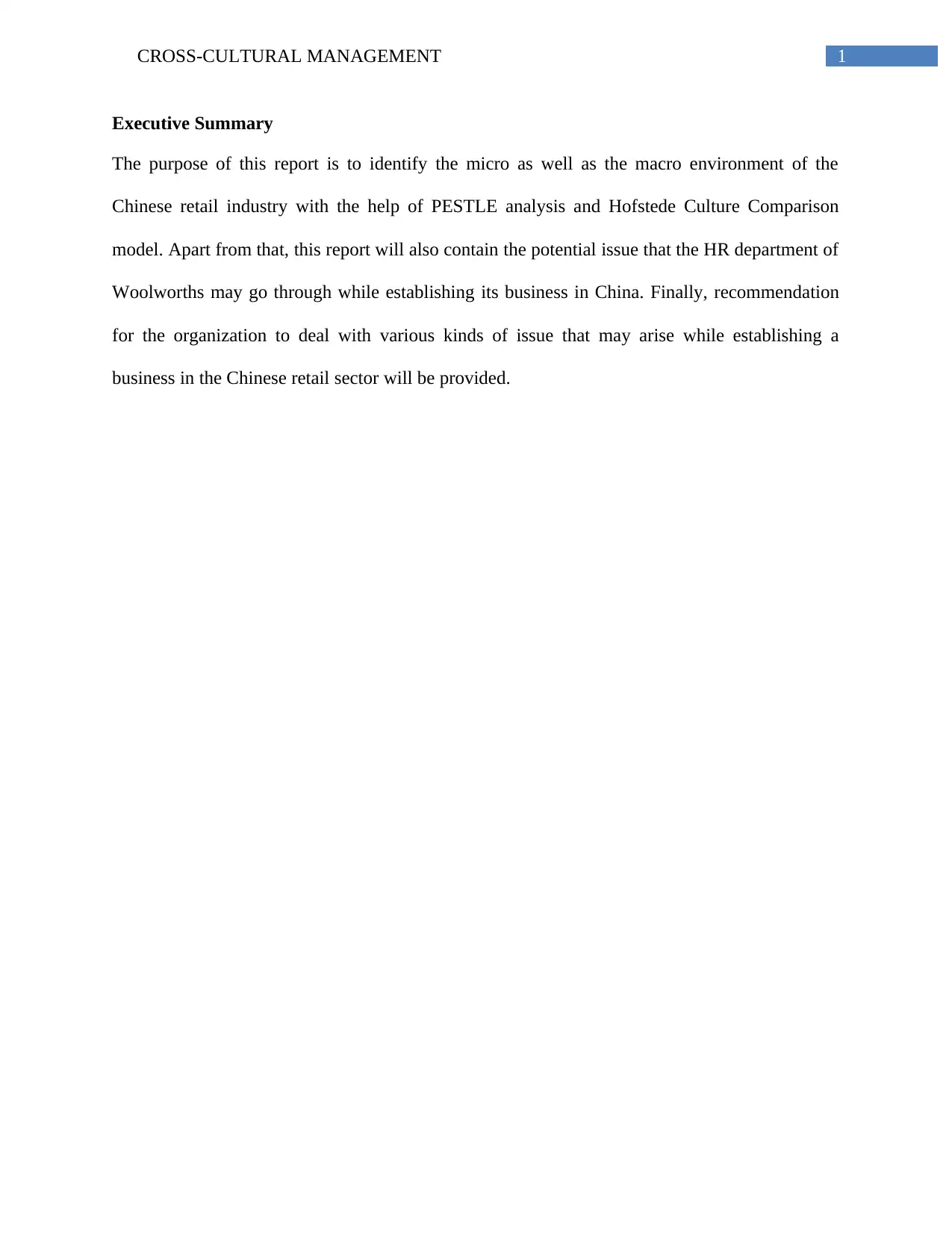
1CROSS-CULTURAL MANAGEMENT
Executive Summary
The purpose of this report is to identify the micro as well as the macro environment of the
Chinese retail industry with the help of PESTLE analysis and Hofstede Culture Comparison
model. Apart from that, this report will also contain the potential issue that the HR department of
Woolworths may go through while establishing its business in China. Finally, recommendation
for the organization to deal with various kinds of issue that may arise while establishing a
business in the Chinese retail sector will be provided.
Executive Summary
The purpose of this report is to identify the micro as well as the macro environment of the
Chinese retail industry with the help of PESTLE analysis and Hofstede Culture Comparison
model. Apart from that, this report will also contain the potential issue that the HR department of
Woolworths may go through while establishing its business in China. Finally, recommendation
for the organization to deal with various kinds of issue that may arise while establishing a
business in the Chinese retail sector will be provided.
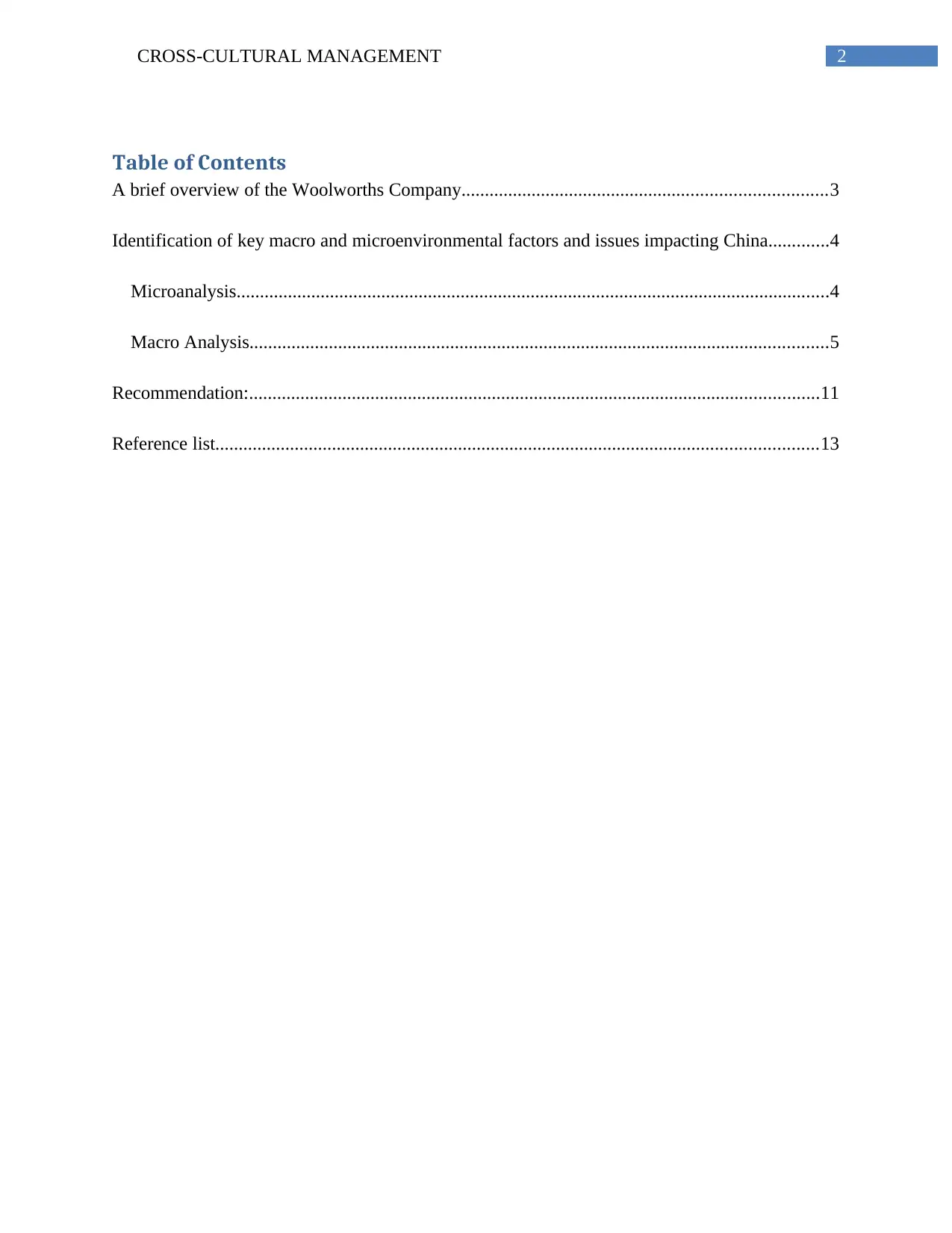
2CROSS-CULTURAL MANAGEMENT
Table of Contents
A brief overview of the Woolworths Company..............................................................................3
Identification of key macro and microenvironmental factors and issues impacting China.............4
Microanalysis...............................................................................................................................4
Macro Analysis............................................................................................................................5
Recommendation:..........................................................................................................................11
Reference list.................................................................................................................................13
Table of Contents
A brief overview of the Woolworths Company..............................................................................3
Identification of key macro and microenvironmental factors and issues impacting China.............4
Microanalysis...............................................................................................................................4
Macro Analysis............................................................................................................................5
Recommendation:..........................................................................................................................11
Reference list.................................................................................................................................13
⊘ This is a preview!⊘
Do you want full access?
Subscribe today to unlock all pages.

Trusted by 1+ million students worldwide
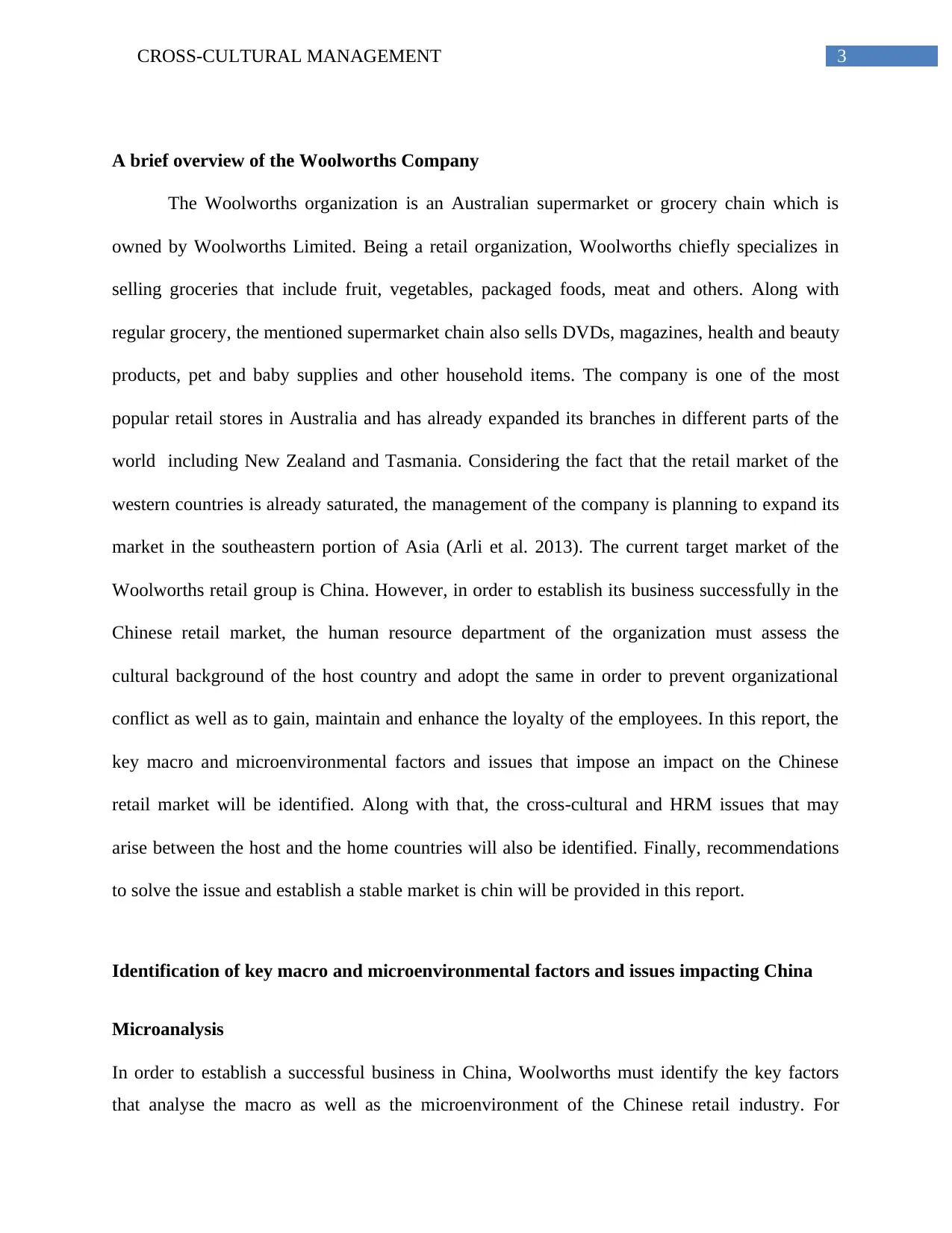
3CROSS-CULTURAL MANAGEMENT
A brief overview of the Woolworths Company
The Woolworths organization is an Australian supermarket or grocery chain which is
owned by Woolworths Limited. Being a retail organization, Woolworths chiefly specializes in
selling groceries that include fruit, vegetables, packaged foods, meat and others. Along with
regular grocery, the mentioned supermarket chain also sells DVDs, magazines, health and beauty
products, pet and baby supplies and other household items. The company is one of the most
popular retail stores in Australia and has already expanded its branches in different parts of the
world including New Zealand and Tasmania. Considering the fact that the retail market of the
western countries is already saturated, the management of the company is planning to expand its
market in the southeastern portion of Asia (Arli et al. 2013). The current target market of the
Woolworths retail group is China. However, in order to establish its business successfully in the
Chinese retail market, the human resource department of the organization must assess the
cultural background of the host country and adopt the same in order to prevent organizational
conflict as well as to gain, maintain and enhance the loyalty of the employees. In this report, the
key macro and microenvironmental factors and issues that impose an impact on the Chinese
retail market will be identified. Along with that, the cross-cultural and HRM issues that may
arise between the host and the home countries will also be identified. Finally, recommendations
to solve the issue and establish a stable market is chin will be provided in this report.
Identification of key macro and microenvironmental factors and issues impacting China
Microanalysis
In order to establish a successful business in China, Woolworths must identify the key factors
that analyse the macro as well as the microenvironment of the Chinese retail industry. For
A brief overview of the Woolworths Company
The Woolworths organization is an Australian supermarket or grocery chain which is
owned by Woolworths Limited. Being a retail organization, Woolworths chiefly specializes in
selling groceries that include fruit, vegetables, packaged foods, meat and others. Along with
regular grocery, the mentioned supermarket chain also sells DVDs, magazines, health and beauty
products, pet and baby supplies and other household items. The company is one of the most
popular retail stores in Australia and has already expanded its branches in different parts of the
world including New Zealand and Tasmania. Considering the fact that the retail market of the
western countries is already saturated, the management of the company is planning to expand its
market in the southeastern portion of Asia (Arli et al. 2013). The current target market of the
Woolworths retail group is China. However, in order to establish its business successfully in the
Chinese retail market, the human resource department of the organization must assess the
cultural background of the host country and adopt the same in order to prevent organizational
conflict as well as to gain, maintain and enhance the loyalty of the employees. In this report, the
key macro and microenvironmental factors and issues that impose an impact on the Chinese
retail market will be identified. Along with that, the cross-cultural and HRM issues that may
arise between the host and the home countries will also be identified. Finally, recommendations
to solve the issue and establish a stable market is chin will be provided in this report.
Identification of key macro and microenvironmental factors and issues impacting China
Microanalysis
In order to establish a successful business in China, Woolworths must identify the key factors
that analyse the macro as well as the microenvironment of the Chinese retail industry. For
Paraphrase This Document
Need a fresh take? Get an instant paraphrase of this document with our AI Paraphraser
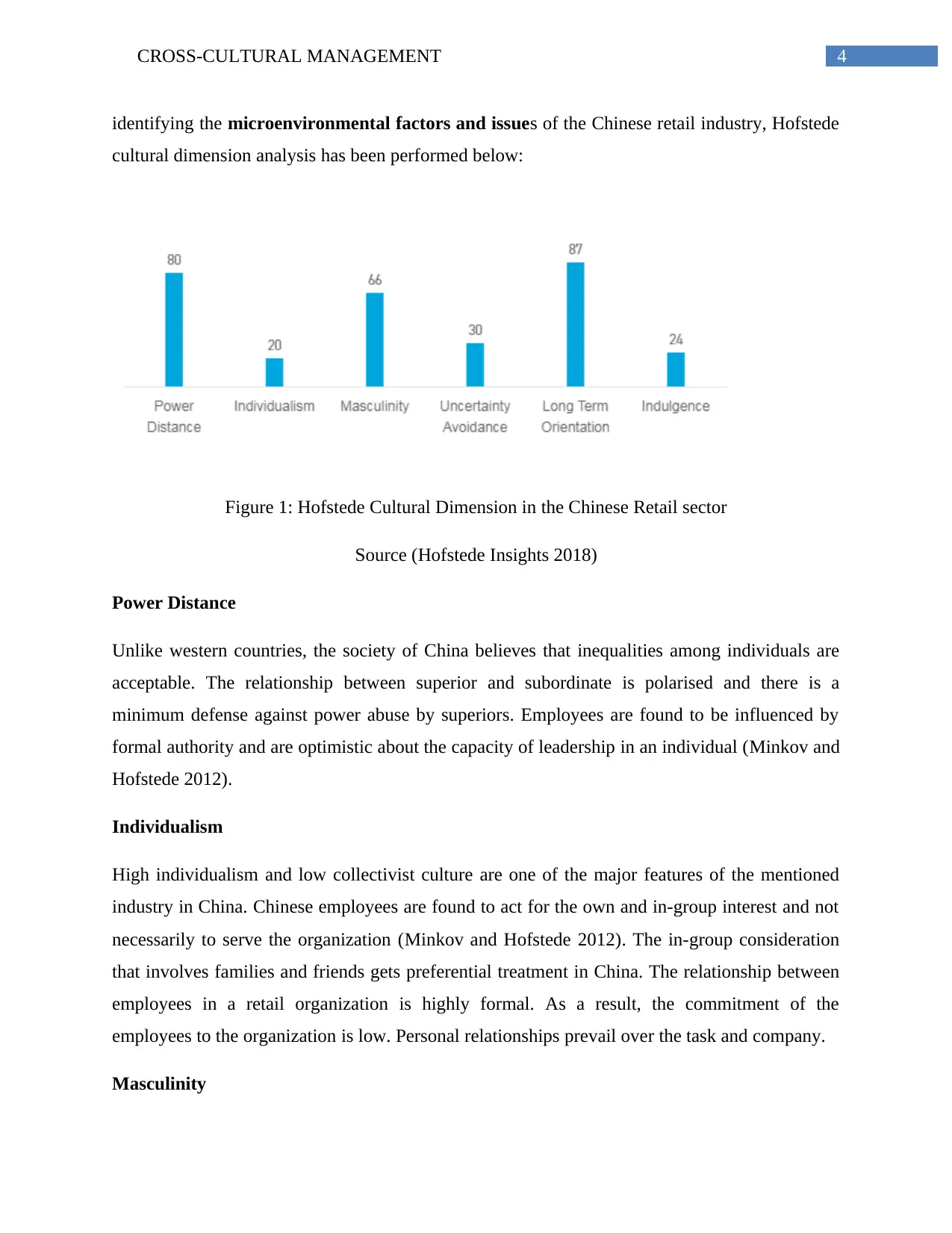
4CROSS-CULTURAL MANAGEMENT
identifying the microenvironmental factors and issues of the Chinese retail industry, Hofstede
cultural dimension analysis has been performed below:
Figure 1: Hofstede Cultural Dimension in the Chinese Retail sector
Source (Hofstede Insights 2018)
Power Distance
Unlike western countries, the society of China believes that inequalities among individuals are
acceptable. The relationship between superior and subordinate is polarised and there is a
minimum defense against power abuse by superiors. Employees are found to be influenced by
formal authority and are optimistic about the capacity of leadership in an individual (Minkov and
Hofstede 2012).
Individualism
High individualism and low collectivist culture are one of the major features of the mentioned
industry in China. Chinese employees are found to act for the own and in-group interest and not
necessarily to serve the organization (Minkov and Hofstede 2012). The in-group consideration
that involves families and friends gets preferential treatment in China. The relationship between
employees in a retail organization is highly formal. As a result, the commitment of the
employees to the organization is low. Personal relationships prevail over the task and company.
Masculinity
identifying the microenvironmental factors and issues of the Chinese retail industry, Hofstede
cultural dimension analysis has been performed below:
Figure 1: Hofstede Cultural Dimension in the Chinese Retail sector
Source (Hofstede Insights 2018)
Power Distance
Unlike western countries, the society of China believes that inequalities among individuals are
acceptable. The relationship between superior and subordinate is polarised and there is a
minimum defense against power abuse by superiors. Employees are found to be influenced by
formal authority and are optimistic about the capacity of leadership in an individual (Minkov and
Hofstede 2012).
Individualism
High individualism and low collectivist culture are one of the major features of the mentioned
industry in China. Chinese employees are found to act for the own and in-group interest and not
necessarily to serve the organization (Minkov and Hofstede 2012). The in-group consideration
that involves families and friends gets preferential treatment in China. The relationship between
employees in a retail organization is highly formal. As a result, the commitment of the
employees to the organization is low. Personal relationships prevail over the task and company.
Masculinity
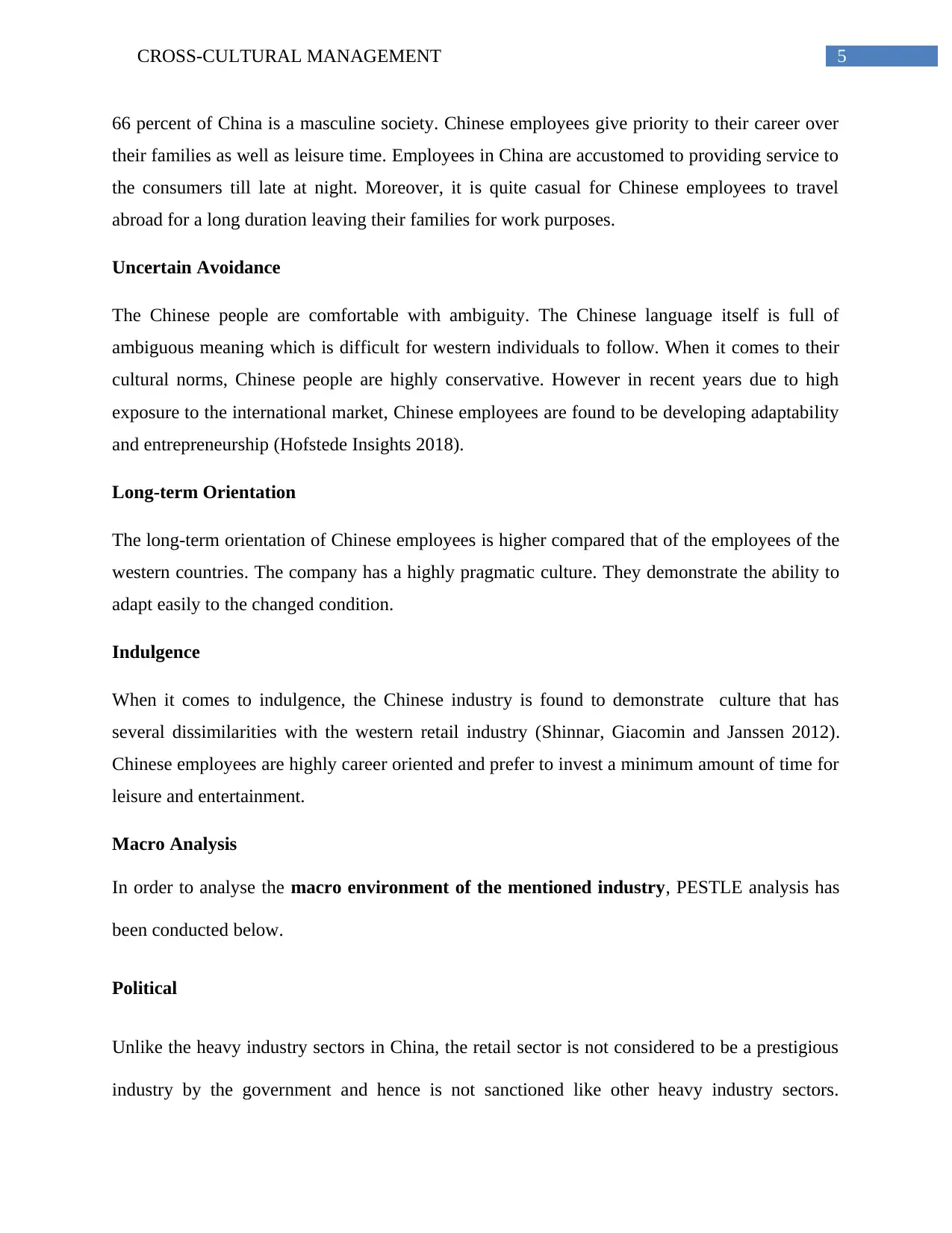
5CROSS-CULTURAL MANAGEMENT
66 percent of China is a masculine society. Chinese employees give priority to their career over
their families as well as leisure time. Employees in China are accustomed to providing service to
the consumers till late at night. Moreover, it is quite casual for Chinese employees to travel
abroad for a long duration leaving their families for work purposes.
Uncertain Avoidance
The Chinese people are comfortable with ambiguity. The Chinese language itself is full of
ambiguous meaning which is difficult for western individuals to follow. When it comes to their
cultural norms, Chinese people are highly conservative. However in recent years due to high
exposure to the international market, Chinese employees are found to be developing adaptability
and entrepreneurship (Hofstede Insights 2018).
Long-term Orientation
The long-term orientation of Chinese employees is higher compared that of the employees of the
western countries. The company has a highly pragmatic culture. They demonstrate the ability to
adapt easily to the changed condition.
Indulgence
When it comes to indulgence, the Chinese industry is found to demonstrate culture that has
several dissimilarities with the western retail industry (Shinnar, Giacomin and Janssen 2012).
Chinese employees are highly career oriented and prefer to invest a minimum amount of time for
leisure and entertainment.
Macro Analysis
In order to analyse the macro environment of the mentioned industry, PESTLE analysis has
been conducted below.
Political
Unlike the heavy industry sectors in China, the retail sector is not considered to be a prestigious
industry by the government and hence is not sanctioned like other heavy industry sectors.
66 percent of China is a masculine society. Chinese employees give priority to their career over
their families as well as leisure time. Employees in China are accustomed to providing service to
the consumers till late at night. Moreover, it is quite casual for Chinese employees to travel
abroad for a long duration leaving their families for work purposes.
Uncertain Avoidance
The Chinese people are comfortable with ambiguity. The Chinese language itself is full of
ambiguous meaning which is difficult for western individuals to follow. When it comes to their
cultural norms, Chinese people are highly conservative. However in recent years due to high
exposure to the international market, Chinese employees are found to be developing adaptability
and entrepreneurship (Hofstede Insights 2018).
Long-term Orientation
The long-term orientation of Chinese employees is higher compared that of the employees of the
western countries. The company has a highly pragmatic culture. They demonstrate the ability to
adapt easily to the changed condition.
Indulgence
When it comes to indulgence, the Chinese industry is found to demonstrate culture that has
several dissimilarities with the western retail industry (Shinnar, Giacomin and Janssen 2012).
Chinese employees are highly career oriented and prefer to invest a minimum amount of time for
leisure and entertainment.
Macro Analysis
In order to analyse the macro environment of the mentioned industry, PESTLE analysis has
been conducted below.
Political
Unlike the heavy industry sectors in China, the retail sector is not considered to be a prestigious
industry by the government and hence is not sanctioned like other heavy industry sectors.
⊘ This is a preview!⊘
Do you want full access?
Subscribe today to unlock all pages.

Trusted by 1+ million students worldwide
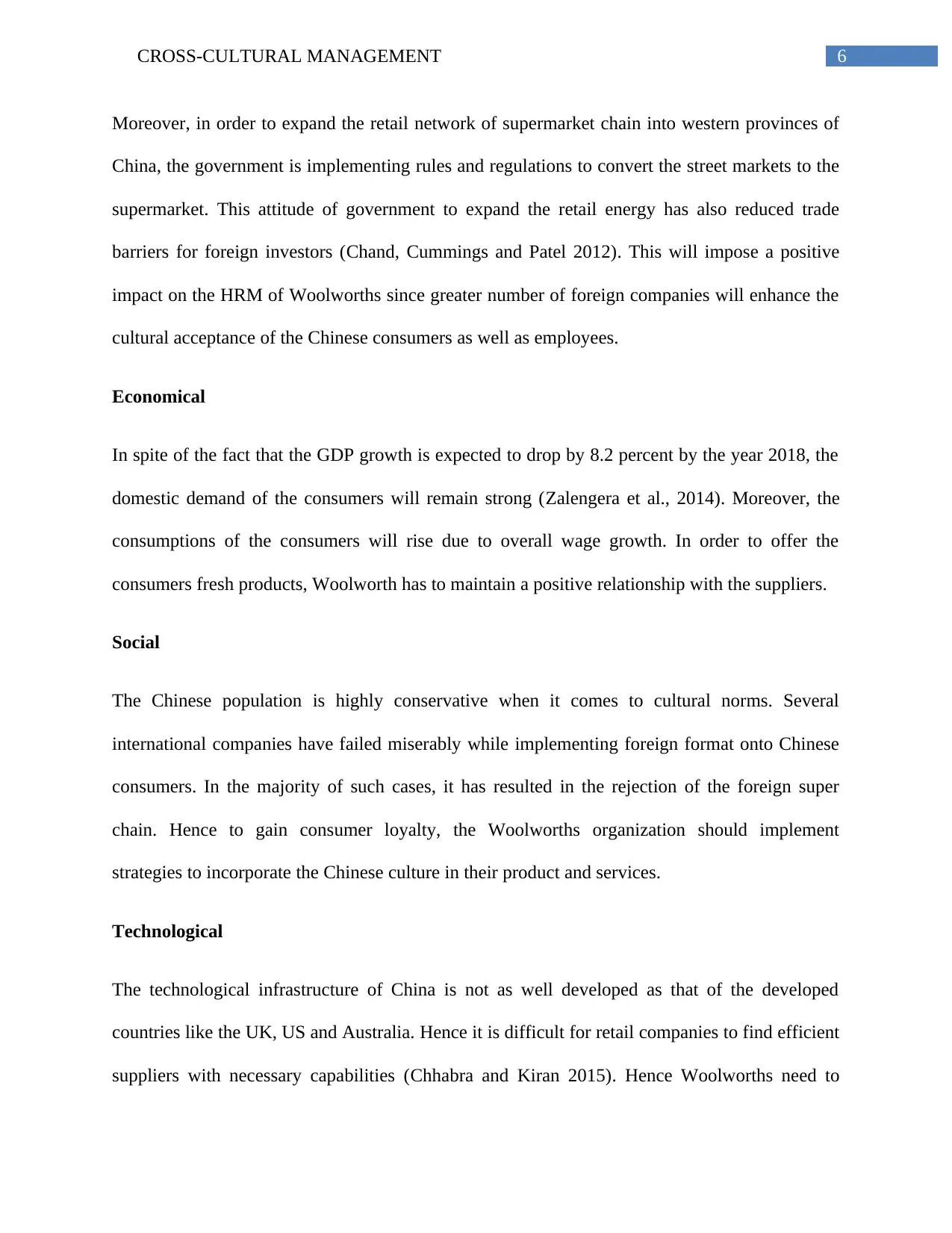
6CROSS-CULTURAL MANAGEMENT
Moreover, in order to expand the retail network of supermarket chain into western provinces of
China, the government is implementing rules and regulations to convert the street markets to the
supermarket. This attitude of government to expand the retail energy has also reduced trade
barriers for foreign investors (Chand, Cummings and Patel 2012). This will impose a positive
impact on the HRM of Woolworths since greater number of foreign companies will enhance the
cultural acceptance of the Chinese consumers as well as employees.
Economical
In spite of the fact that the GDP growth is expected to drop by 8.2 percent by the year 2018, the
domestic demand of the consumers will remain strong (Zalengera et al., 2014). Moreover, the
consumptions of the consumers will rise due to overall wage growth. In order to offer the
consumers fresh products, Woolworth has to maintain a positive relationship with the suppliers.
Social
The Chinese population is highly conservative when it comes to cultural norms. Several
international companies have failed miserably while implementing foreign format onto Chinese
consumers. In the majority of such cases, it has resulted in the rejection of the foreign super
chain. Hence to gain consumer loyalty, the Woolworths organization should implement
strategies to incorporate the Chinese culture in their product and services.
Technological
The technological infrastructure of China is not as well developed as that of the developed
countries like the UK, US and Australia. Hence it is difficult for retail companies to find efficient
suppliers with necessary capabilities (Chhabra and Kiran 2015). Hence Woolworths need to
Moreover, in order to expand the retail network of supermarket chain into western provinces of
China, the government is implementing rules and regulations to convert the street markets to the
supermarket. This attitude of government to expand the retail energy has also reduced trade
barriers for foreign investors (Chand, Cummings and Patel 2012). This will impose a positive
impact on the HRM of Woolworths since greater number of foreign companies will enhance the
cultural acceptance of the Chinese consumers as well as employees.
Economical
In spite of the fact that the GDP growth is expected to drop by 8.2 percent by the year 2018, the
domestic demand of the consumers will remain strong (Zalengera et al., 2014). Moreover, the
consumptions of the consumers will rise due to overall wage growth. In order to offer the
consumers fresh products, Woolworth has to maintain a positive relationship with the suppliers.
Social
The Chinese population is highly conservative when it comes to cultural norms. Several
international companies have failed miserably while implementing foreign format onto Chinese
consumers. In the majority of such cases, it has resulted in the rejection of the foreign super
chain. Hence to gain consumer loyalty, the Woolworths organization should implement
strategies to incorporate the Chinese culture in their product and services.
Technological
The technological infrastructure of China is not as well developed as that of the developed
countries like the UK, US and Australia. Hence it is difficult for retail companies to find efficient
suppliers with necessary capabilities (Chhabra and Kiran 2015). Hence Woolworths need to
Paraphrase This Document
Need a fresh take? Get an instant paraphrase of this document with our AI Paraphraser

7CROSS-CULTURAL MANAGEMENT
maintain a good communication and relationship with the local suppliers since their power is
high in the Chinese retail industry.
Legal
The government's policies of monopoly control and reduction of buyers' power can limit entry to
the sector with such controls as license requirement and limits on access to raw materials.This
will definitely impose negative impact on Woolworths since it trying to expand its market in the
Chinese retail sector.
Environmental
The government of China has recently abolished the usage of plastic bags in China and is
introducing recycling programs through its National and Social Progress Plan. As a result of this,
majority of organizations in China, specially the retail and fast fod compaies are using eco-
friendly packaging materials. In order to enhance its consumer loyalty in the Chinese market,
Woolworths needs to abide by the environmental rules and regulations.
Identification of key cross-cultural and HRM issues that may arise between home & host
countries
From the microanalysis performed above, it can be understood that the Chinese culture is highly
different from the culture of Australia. These differences in culture have the potential to bring
about several cross-cultural issues between employees with origin in Australia and China.
Communication Misunderstanding: Considering the fact that China is a developing country,
only 22 percent of the population can fluently speak English (Yek 2014). This is highly
disadvantageous for the foreign retail organizations including Woolworths who want to establish
their market in the Chinese retail sector. A high communication gap between the employees of
the organization and between the consumers and the employees will take place. Communication
maintain a good communication and relationship with the local suppliers since their power is
high in the Chinese retail industry.
Legal
The government's policies of monopoly control and reduction of buyers' power can limit entry to
the sector with such controls as license requirement and limits on access to raw materials.This
will definitely impose negative impact on Woolworths since it trying to expand its market in the
Chinese retail sector.
Environmental
The government of China has recently abolished the usage of plastic bags in China and is
introducing recycling programs through its National and Social Progress Plan. As a result of this,
majority of organizations in China, specially the retail and fast fod compaies are using eco-
friendly packaging materials. In order to enhance its consumer loyalty in the Chinese market,
Woolworths needs to abide by the environmental rules and regulations.
Identification of key cross-cultural and HRM issues that may arise between home & host
countries
From the microanalysis performed above, it can be understood that the Chinese culture is highly
different from the culture of Australia. These differences in culture have the potential to bring
about several cross-cultural issues between employees with origin in Australia and China.
Communication Misunderstanding: Considering the fact that China is a developing country,
only 22 percent of the population can fluently speak English (Yek 2014). This is highly
disadvantageous for the foreign retail organizations including Woolworths who want to establish
their market in the Chinese retail sector. A high communication gap between the employees of
the organization and between the consumers and the employees will take place. Communication
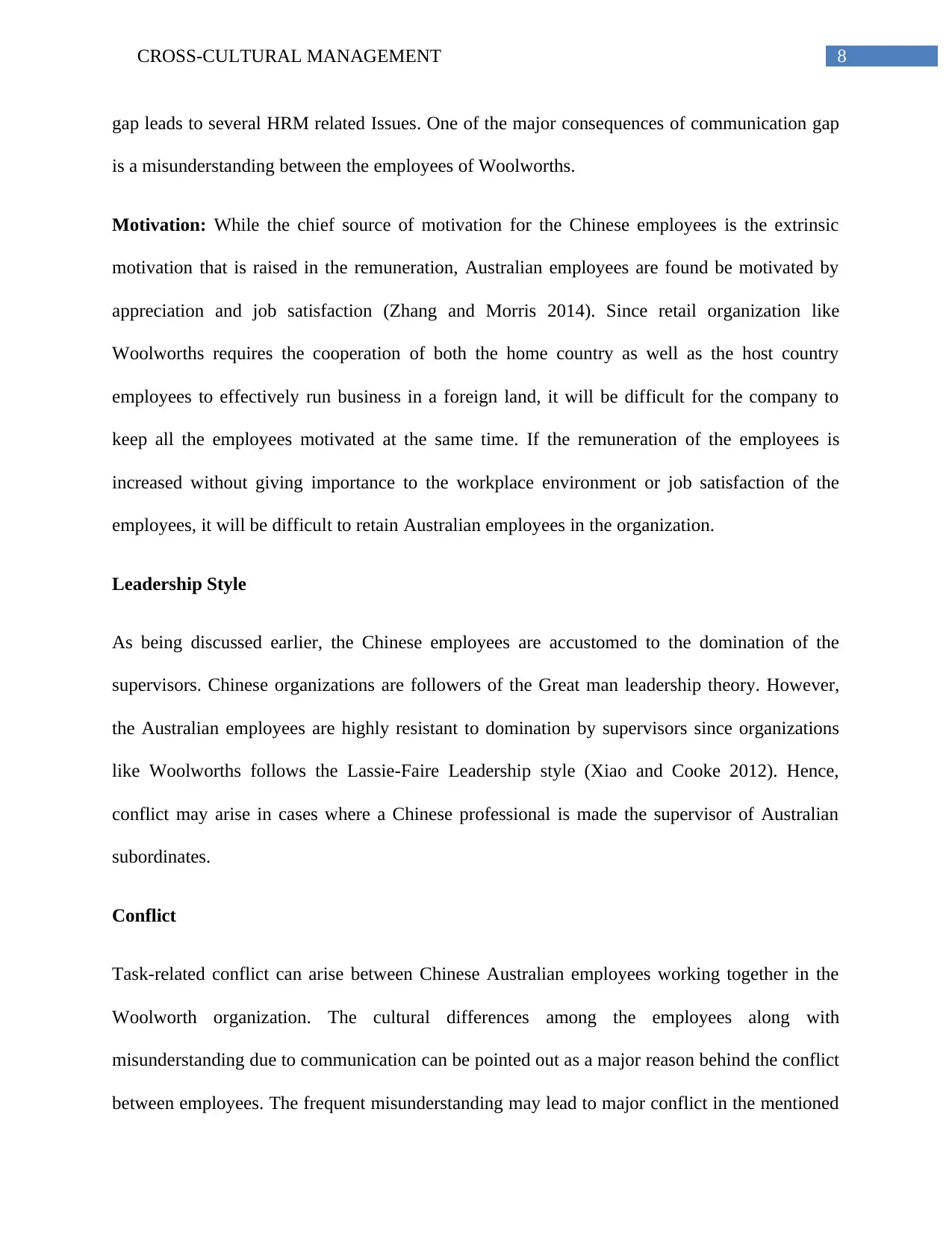
8CROSS-CULTURAL MANAGEMENT
gap leads to several HRM related Issues. One of the major consequences of communication gap
is a misunderstanding between the employees of Woolworths.
Motivation: While the chief source of motivation for the Chinese employees is the extrinsic
motivation that is raised in the remuneration, Australian employees are found be motivated by
appreciation and job satisfaction (Zhang and Morris 2014). Since retail organization like
Woolworths requires the cooperation of both the home country as well as the host country
employees to effectively run business in a foreign land, it will be difficult for the company to
keep all the employees motivated at the same time. If the remuneration of the employees is
increased without giving importance to the workplace environment or job satisfaction of the
employees, it will be difficult to retain Australian employees in the organization.
Leadership Style
As being discussed earlier, the Chinese employees are accustomed to the domination of the
supervisors. Chinese organizations are followers of the Great man leadership theory. However,
the Australian employees are highly resistant to domination by supervisors since organizations
like Woolworths follows the Lassie-Faire Leadership style (Xiao and Cooke 2012). Hence,
conflict may arise in cases where a Chinese professional is made the supervisor of Australian
subordinates.
Conflict
Task-related conflict can arise between Chinese Australian employees working together in the
Woolworth organization. The cultural differences among the employees along with
misunderstanding due to communication can be pointed out as a major reason behind the conflict
between employees. The frequent misunderstanding may lead to major conflict in the mentioned
gap leads to several HRM related Issues. One of the major consequences of communication gap
is a misunderstanding between the employees of Woolworths.
Motivation: While the chief source of motivation for the Chinese employees is the extrinsic
motivation that is raised in the remuneration, Australian employees are found be motivated by
appreciation and job satisfaction (Zhang and Morris 2014). Since retail organization like
Woolworths requires the cooperation of both the home country as well as the host country
employees to effectively run business in a foreign land, it will be difficult for the company to
keep all the employees motivated at the same time. If the remuneration of the employees is
increased without giving importance to the workplace environment or job satisfaction of the
employees, it will be difficult to retain Australian employees in the organization.
Leadership Style
As being discussed earlier, the Chinese employees are accustomed to the domination of the
supervisors. Chinese organizations are followers of the Great man leadership theory. However,
the Australian employees are highly resistant to domination by supervisors since organizations
like Woolworths follows the Lassie-Faire Leadership style (Xiao and Cooke 2012). Hence,
conflict may arise in cases where a Chinese professional is made the supervisor of Australian
subordinates.
Conflict
Task-related conflict can arise between Chinese Australian employees working together in the
Woolworth organization. The cultural differences among the employees along with
misunderstanding due to communication can be pointed out as a major reason behind the conflict
between employees. The frequent misunderstanding may lead to major conflict in the mentioned
⊘ This is a preview!⊘
Do you want full access?
Subscribe today to unlock all pages.

Trusted by 1+ million students worldwide

9CROSS-CULTURAL MANAGEMENT
organization which in turn has the potential to reduce the overall productivity and revenue of the
organization in the retail market of China. Moreover, the lack of communication will hinder the
development of the effective relationship between the employees and supervisors of the
organization. Effective employee to employee or employee to supervisor relation has the
potential to enhance the loyalty of the employees towards the organization as well as work
environment of Woolworths (Briscoe, Tarique and Schuler 2012). Besides that, the HR
professionals of Woolworths will also face difficulties while providing necessary information to
the employees. While information written in the English language will be difficult for Chinese
employee to understand, Australian employees will not be able to understand information written
in the Chinese language.
Leisure
From the Hofstede graph, it can be clearly understood that leisure and entertainment play a
major role in motivating Australian employees, Chinese employees are totally reluctant to leisure
and consider leisure period to be wastage of time. This can create issues in Woolworths. While it
will be difficult to retain Australian employees if the number of holidays is reduced, Chinese
employees may tend to start other part-time businesses if the number of holidays provided by the
organization is more than their requirement.
Individualism
Since favouritism workplace is common in Chinese retail organizations, the same thing will be
expected in Woolworths. On the other hand, Australia employees are highly defensive towards
favouritism (Warner 2014). This may give birth to conflicts in the organization. Apart from that,
organization which in turn has the potential to reduce the overall productivity and revenue of the
organization in the retail market of China. Moreover, the lack of communication will hinder the
development of the effective relationship between the employees and supervisors of the
organization. Effective employee to employee or employee to supervisor relation has the
potential to enhance the loyalty of the employees towards the organization as well as work
environment of Woolworths (Briscoe, Tarique and Schuler 2012). Besides that, the HR
professionals of Woolworths will also face difficulties while providing necessary information to
the employees. While information written in the English language will be difficult for Chinese
employee to understand, Australian employees will not be able to understand information written
in the Chinese language.
Leisure
From the Hofstede graph, it can be clearly understood that leisure and entertainment play a
major role in motivating Australian employees, Chinese employees are totally reluctant to leisure
and consider leisure period to be wastage of time. This can create issues in Woolworths. While it
will be difficult to retain Australian employees if the number of holidays is reduced, Chinese
employees may tend to start other part-time businesses if the number of holidays provided by the
organization is more than their requirement.
Individualism
Since favouritism workplace is common in Chinese retail organizations, the same thing will be
expected in Woolworths. On the other hand, Australia employees are highly defensive towards
favouritism (Warner 2014). This may give birth to conflicts in the organization. Apart from that,
Paraphrase This Document
Need a fresh take? Get an instant paraphrase of this document with our AI Paraphraser
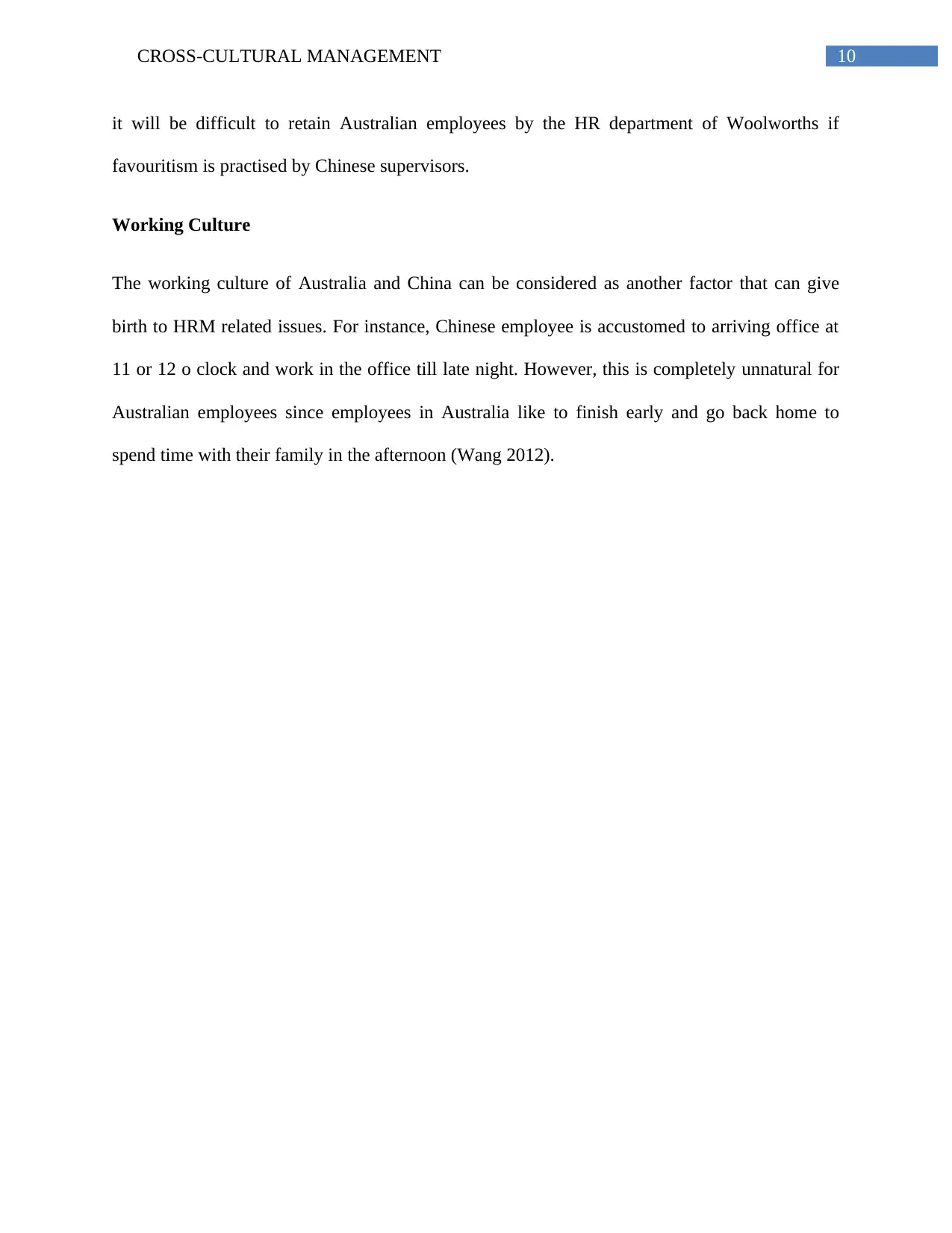
10CROSS-CULTURAL MANAGEMENT
it will be difficult to retain Australian employees by the HR department of Woolworths if
favouritism is practised by Chinese supervisors.
Working Culture
The working culture of Australia and China can be considered as another factor that can give
birth to HRM related issues. For instance, Chinese employee is accustomed to arriving office at
11 or 12 o clock and work in the office till late night. However, this is completely unnatural for
Australian employees since employees in Australia like to finish early and go back home to
spend time with their family in the afternoon (Wang 2012).
it will be difficult to retain Australian employees by the HR department of Woolworths if
favouritism is practised by Chinese supervisors.
Working Culture
The working culture of Australia and China can be considered as another factor that can give
birth to HRM related issues. For instance, Chinese employee is accustomed to arriving office at
11 or 12 o clock and work in the office till late night. However, this is completely unnatural for
Australian employees since employees in Australia like to finish early and go back home to
spend time with their family in the afternoon (Wang 2012).
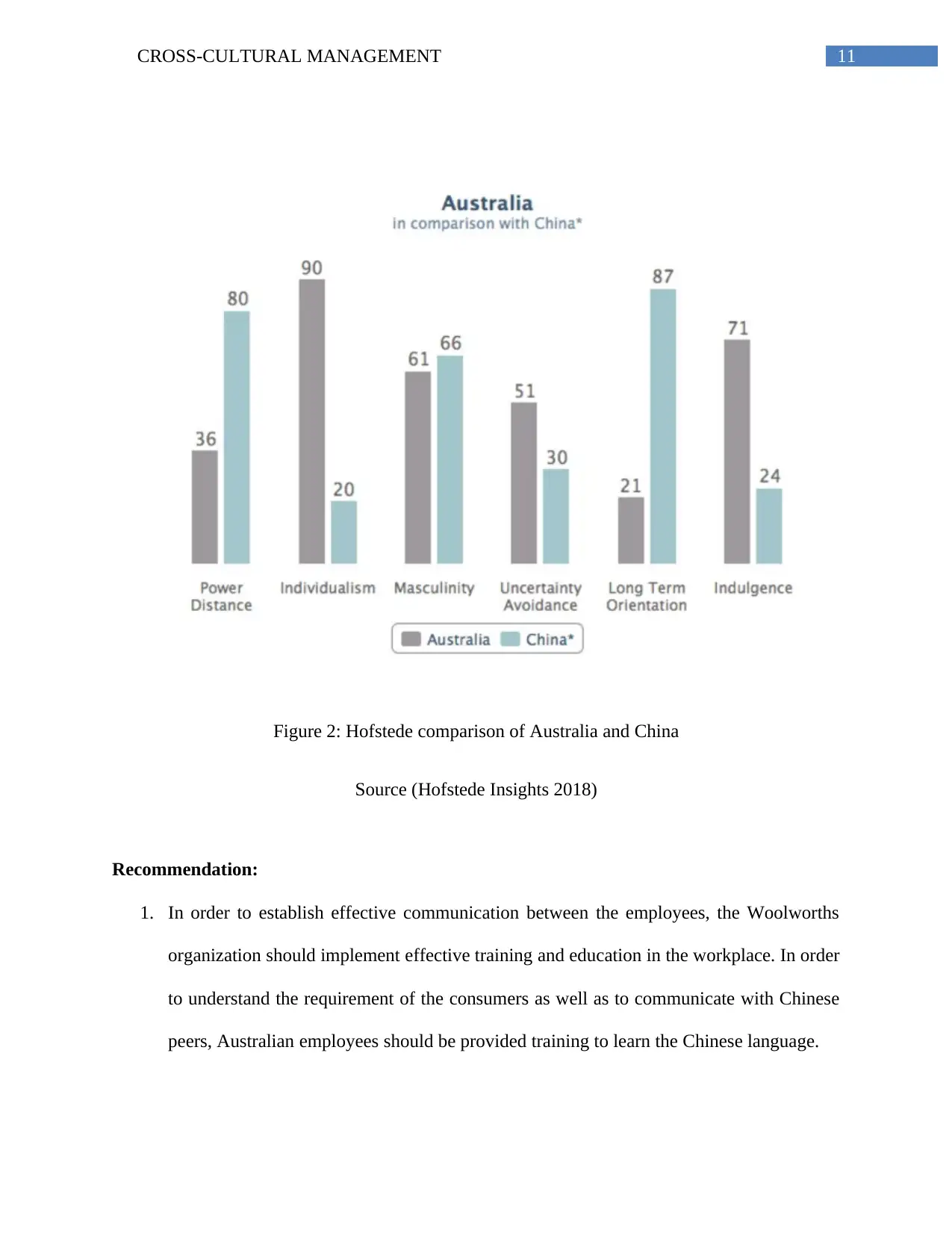
11CROSS-CULTURAL MANAGEMENT
Figure 2: Hofstede comparison of Australia and China
Source (Hofstede Insights 2018)
Recommendation:
1. In order to establish effective communication between the employees, the Woolworths
organization should implement effective training and education in the workplace. In order
to understand the requirement of the consumers as well as to communicate with Chinese
peers, Australian employees should be provided training to learn the Chinese language.
Figure 2: Hofstede comparison of Australia and China
Source (Hofstede Insights 2018)
Recommendation:
1. In order to establish effective communication between the employees, the Woolworths
organization should implement effective training and education in the workplace. In order
to understand the requirement of the consumers as well as to communicate with Chinese
peers, Australian employees should be provided training to learn the Chinese language.
⊘ This is a preview!⊘
Do you want full access?
Subscribe today to unlock all pages.

Trusted by 1+ million students worldwide
1 out of 17
Related Documents
Your All-in-One AI-Powered Toolkit for Academic Success.
+13062052269
info@desklib.com
Available 24*7 on WhatsApp / Email
![[object Object]](/_next/static/media/star-bottom.7253800d.svg)
Unlock your academic potential
Copyright © 2020–2025 A2Z Services. All Rights Reserved. Developed and managed by ZUCOL.





